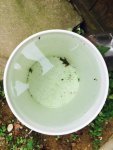- May 23, 2015
- 24,502
- Pool Size
- 16000
- Surface
- Plaster
- Chlorine
- Salt Water Generator
- SWG Type
- Pentair Intellichlor IC-60
I say try the pond water. Just grab a sample from a swampy green part of the pond. Should be enough.
You will need to mark water levels and keep the buckets level. I suggest topping off with bottled water. It has a pH in the 7-8 range with some alkalinity and no chlorine. So it should be good.
You might see if you can just buy some phosphate only fertilizer as opposed to using general fertilizer or else I think you might wind up crashing your pH again. Sometimes garden stores sell a phosphorous only treatment for stimulating flowering.
Sent from my iPhone using Tapatalk
You will need to mark water levels and keep the buckets level. I suggest topping off with bottled water. It has a pH in the 7-8 range with some alkalinity and no chlorine. So it should be good.
You might see if you can just buy some phosphate only fertilizer as opposed to using general fertilizer or else I think you might wind up crashing your pH again. Sometimes garden stores sell a phosphorous only treatment for stimulating flowering.
Sent from my iPhone using Tapatalk



